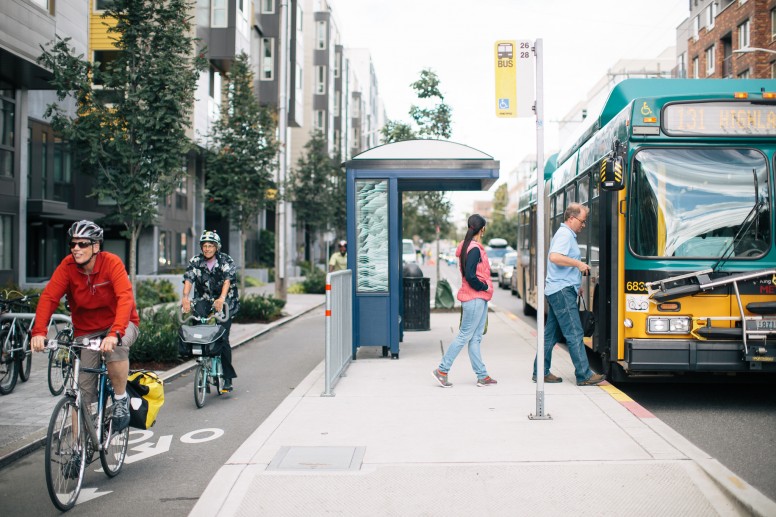After two weeks of negotiations, 196 nations present at the 2015 Paris Climate Conference reached a historic agreement to stave off the worst possible consequences of climate change. Signatories committed to reducing their greenhouse gas emissions to limit rising global temperatures to below two degrees Celsius.
The Paris climate agreement requires countries to report their progress on cutting emissions every five years, but national pledges to reduce those emissions are voluntary. Roughly one-third of the remaining global carbon budget will be determined by urban policy decisions made at the local level. In other words, much of the weight to mitigate a potential global disaster will fall on sub-national governments led by state and municipal leaders.
And those leaders needn’t look any further than transportation to make drastic reductions to emission levels. Transportation is responsible for 22 percent of global GHG emissions and is the fastest growing source of CO2. Major cities like Beijing, New Delhi and Paris have already taken steps to encourage more residents to opt for more GHG-efficient travel modes, like walking, driving and taking transit.
For the U.S., it’s a similar story: 27 percent of nationwide emissions comes from transportation, and despite improvements to the general fuel economy, those CO2 emissions have grown for the past two years.
Some tri-state leaders have already committed to doing their part. Two weeks ago, Connecticut Governor Dannel Malloy signed the Under 2 MOU, joining the leaders of three U.S. cities and seven states, including New York Governor Andrew Cuomo and New York City Mayor Bill de Blasio. Participants aim to reduce their emissions by 80 to 95 percent below 1990 levels by 2050.
For both states, transportation is the largest contributor of GHG emissions–meaning it also presents the largest opportunity to cut emissions. Even for transit-dependent New York State, transportation represents a third of statewide emissions. In Connecticut, where more than three-quarters of commuters drive alone, transportation is accountable for 40 percent of statewide emissions.
Signing the Under 2 MOU is largely symbolic, since it is a non-binding agreement and both states have already established climate action plans. But if New York and Connecticut seriously want to play a global or even national role in mitigating climate change, their leaders need to stop pushing projects that induce more driving and focus on those that encourage people to walk, bike and take transit.
Under Governor Malloy, Connecticut has seen significant steps to a more sustainable transportation network, including the debut of the CTfastrak bus rapid transit system and bike law reform. And yet, the governor continues to push for the widening of Interstates 84 and 95–projects that would lead to more cars emitting more GHG emissions.
Meanwhile in New York, Governor Cuomo and Mayor de Blasio both have framed toll pricing reform within NYC as a political nonstarter. The plan, which would charge people driving into lower Manhattan, is projected to bring in $1.125 billion in annual revenue designated for transit investments, while cutting congestion. A similar plan in Central London resulted in a 16 percent decline in CO2 emissions within the charging zone as drivers switched to alternative means, like biking or transit.
Still, Governors Cuomo and Malloy and Mayor de Blasio already have relatively strong environmental records, though room for improvement remains. Their adoption of the Under 2 MOU may be simply emblematic in light of the grander Paris climate agreement, but it’s reassuring that some leaders in the tri-state region are taking climate change seriously.


Does the bus at an average occupancy of 20% get more passenger miles per gallon on more circuitous routes that an automobile at average occupancy of 32% (25% in rush hours)? Granted most transit buses in peak period peak direction to downtowns are far more efficient than automobiles, given the sprawled nature of both housing and jobs, much transit is very inefficient and low density.
Actually thanks to fare hikes, cutting NJ Transit budget by 90% from $320 Million to $34 Million, axing NJ Transit train, bus, Lightrail and shuttle service by Gov Christie the NJ DEP now reports that Auto Addiction accounts for 47% of New Jersey greenhouse emissions!
This in a State more densely populated than China with 20 extant Rail rights of way just sitting doing nothing instead of running passenger rail. While NJ Transit continues to cut train and bus service including sneak cuts to the last trains from NYC on 5 Rail lines. New Jersey should be the US leader in Green Transit!
Not wasting $2 Billion on the Urban Transit Hub tax Credit giveaway to corporations or over $7 Billion on expanding the NJ Turnpike and the Garden State Parkway.
[…] Lower tolls undermines GHG reduction targets. Reducing tolls encourages more driving, which leads to increased greenhouse gas emissions. Last fall, Governor Cuomo announced a state commitment to reduce emissions by 80 percent by 2050–and transportation is the largest contributor of New York’s GHG emissions. […]
[…] is the single largest source of ghg emissions in New York. Luckily Governor Cuomo isn’t a climate change denier — in fact his office put out an […]
[…] the EPA, transportation is the second largest source of ghg emissions in the country, comprising 27 percent of total emissions (electricity generation accounts for 31 percent of the nation’s […]
[…] The U.S. recently committed to lofty (yet simultaneously insufficient) climate goals with the Paris Climate Agreement alongside 174 other nations. But collapsing gas prices–coupled with a stagnant federal gas […]
[…] formally go into effect early next month. The treaty aims to curb rising global temperatures within 2 degrees Celsius and requires countries to publicize their emission targets and […]